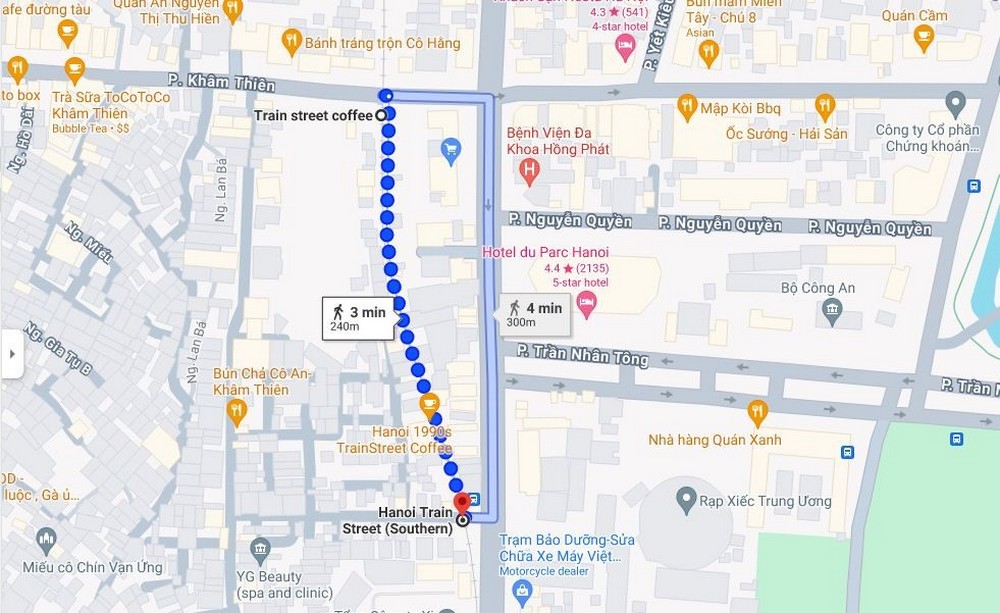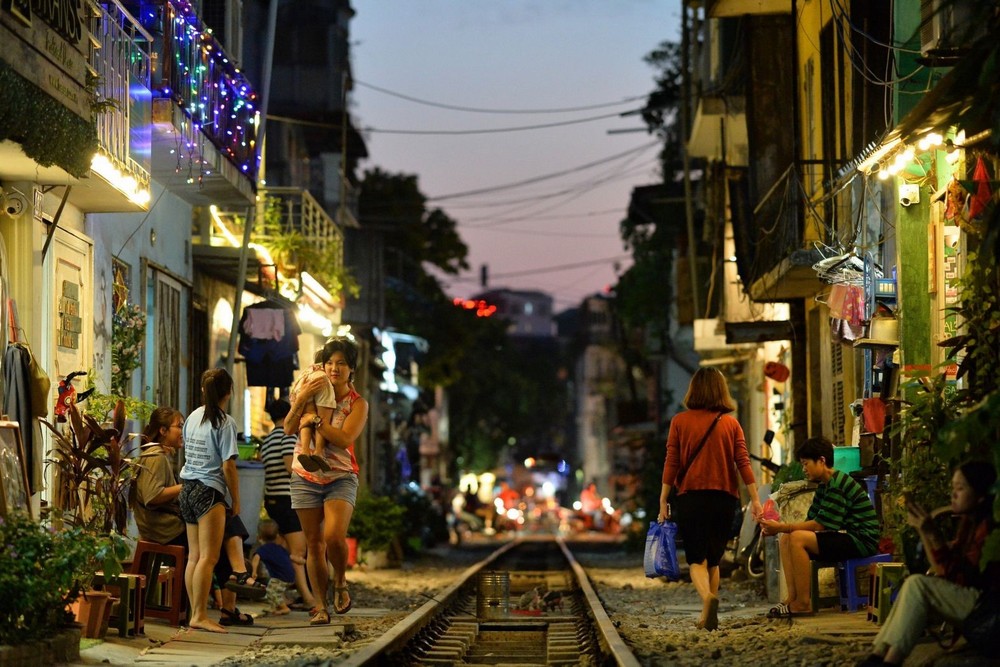Hanoi Train Street: Full Instructions to Visit Hanoi Train Streets
Nestled within Hanoi’s bustling thoroughfares, the train streets hold a unique allure for international tourists exploring Vietnam. Travelers flock to this district to witness its signature local scenery and experience the fascinating sight of trains weaving through residential neighborhoods. In this blog post, we will explore the origins of Hanoi train streets, how to access it, and recommended ways to make the most out of your visit.
Where is the Hanoi Train Street?
The railway system extends throughout Hanoi, but there are two streets in the Old Quarter notably renowned for their train tracks. Hanoi Train Street is also called as Railway Street. It runs between Kham Thien and Le Duan Street or Phung Hung and Tran Phu Street. The street is lined with houses on either side, leaving just enough space for a train to pass through.

Map of Hanoi Train Street in Kham Thien and Le Duan Street
Length: 240 m

Map of Hanoi Train Street in Phung Hung and Tran Phu Street
Length: 600m
Both train streets offer an intriguing atmosphere with two-story coffee shops styled in Vietnamese decor. Here are some recommendations for your visit to these streets.:
- Le Duan Train Street and Phung Hung Train Street are both located in the Old Quarter and are 1.7km apart.
- Le Duan Train Street is located at the entrance of Hanoi Train Station. You can see the train station from the outside as there are ticket checking areas to get inside.
- Phung Hung Train Street is situated deeper within the ancient quarter and is close to the Phung Hung Mural Street.
History of Hanoi Train Street

Hanoi train street history
The railway tracks were built by the French during their occupation of Vietnam in the late 19th century. The tracks were originally used to transport goods and people between Hanoi and other provinces in Vietnam. Over time, the city grew and expanded, and the tracks remained in the same location, surrounded by new buildings and houses.
Today, the train still runs carrying goods and passengers to and from the city. The Hanoi Train is also frequented by many foreign tourists eager to experience it firsthand. Popular routes chosen are Hanoi – Sapa or Hanoi – Hai Phong.
How to Enter Hanoi Train Street
Entering Hanoi Train Street is relatively easy, but there are a few things you should keep in mind to ensure a safe and enjoyable experience.

Visit Hanoi train street
Getting to Hanoi Train Street
The easiest way to get to Hanoi Train Street is by taking a taxi or motorbike taxi (known as “xe om” – Grab Bike in Vietnamese) to the Old Quarter. From there, you can walk to the street or ask your driver to drop you off at the entrance. You can also take a bus to bus stops at Le Duan street, Tran Phu street, or Phung Hung street and then walk to the street .
- Buses stop near Le Duan: 01, 03A, 08B, 08BCT, 11, 11CT, 32, 40, 40CT, 49
- Buses stop near Tran Phu: 01, 18, 36, 36 CT
- Buses stop near Phung Hung: 18
You can visit the train street at these addresses:
- 224 Le Duan, Kham Thien, Dong Da, Hanoi
- No 5 Tran Phu, Hang Bong, Hoan Kiem, Hanoi
- Along Phung Hung street
Tips for Entering Hanoi Train Street
- Check out the train schedule: You should arrive at least 30 minutes before the scheduled time to secure a good spot for viewing.
- Respect the locals: Hanoi Train Street is still a residential area, and people live their daily lives here. Be respectful of the local privacy and do not enter their homes or take photos without permission.
- Stay on the designated walking path: Be attentive when using the designated walking paths and avoid accessing the railway vicinity during, before, and after train operations.
- Keep an eye out for warning signs: There are signs along the street warning visitors of the approaching train. Pay attention to these signs and move to a safe spot when you see them.
- Do not litter: As with any tourist attraction, it is important to keep the area clean and respect the environment. Do not leave any trash behind and dispose of it properly.
- Select suitable footwear: If you intend to stroll along train tracks, it is best to avoid wearing high heels as the tracks are narrow and frequently scattered with small rocks. Walking shoes or sandals are good.
Hanoi Train Street Schedule
You are not obligated to buy any form of ticket to experience the train street. If you decide to sit inside a café and wait for the train to pass, you will need to pay for drinks (beer, tea, coffee, etc).
The train schedules differ between Le Duan Train Street and Phung Hung Train Street. Additionally, train timings vary throughout the year. You can refer to the Hanoi train street timetable updated in 2024 below:

A board showcases Hanoi Train Schedule at local coffee shops
| Day | Time |
| Monday – Sunday (Le Duan Train Street) |
|
| Monday – Friday (Phung Hung Train Street) |
|
| Saturday – Sunday (Phung Hung Train Street) |
|
Where to Watch the Hanoi Train Street?

Spots to see Hanoi Train Street
There are several spots along Hanoi Train Street where you can watch the train pass by. Here are some suggestions for your trip:
- During the wait for the train’s passage, you can take a leisurely stroll along the nearby train street to observe how the railway cuts through the neighborhood, enjoy the scenery on either side, witness local life, and perhaps pick up a few souvenirs.
- Next, you can take advantage of the time before the train passes to capture beautiful photos along the train street, walking on the train tracks, snapping pictures with the shops, walls. A conical hat will be a lovely prop to accentuate your photo with a strong Vietnamese touch.
- Afterward, you might select a café for beverage enjoyment, offering picturesque and secure spots to observe the passing train. Options include outdoor seating alongside the wall, indoor seating, or second-floor seating for a rooftop view of the train.
Local residents in the neighborhood are very friendly and welcoming to visitors. They are willing to offer assistance by suggesting great photo spots, helping to snap the pics for you or lending chairs for better photo opportunities.
What Cafe Should You Go To?

Top Hanoi train street cafe to visit
Along the Hanoi Train Street, there are numerous train-themed cafes offering a diverse range of beverages, delightful seating arrangements, and some with rich stories and memories deeply intertwined with the train street neighborhood… Here are some of the most popular ones:
Café 90 Đường Tàu
The café is located near the entry to Tran Phu’s train street. The space is adorned with simple and classical decor reminiscent of Hanoi’s Old Quarter. Café 90 boasts two floors, giving you the option to sit upstairs or downstairs. The drink menu is diverse, offering options such as coffee, tea, soft drinks, coconut water, etc. (priced between 1.2 – 1.6 USD). Snack options include beef jerky, sunflower seeds, and additionally, they offer a varied menu of traditional Hanoi dishes like stir-fried rice, pho, bun cha, etc, ranging from 1.6 – 2 USD.
Cafe Sân Ga
The café offers a refreshing and laid-back ambiance, complete with potted plants, whimsical decorations, and captivating artwork. Its menu features delightful drinks and dishes. Additionally, visitors can interact with a lovable poodle and two affable cats kept on the premises.
Cafe Ga Dong Duong
Taking cues from train stations, the café adopts a décor theme reminiscent of a train carriage. Dong Duong Cafe earning its reputation as one of the chicest establishments on Tran Phu train street. Its varied menu caters to diverse palates catering to both European and Asian clientele.
Hanoi 1990s – Train Coffee
Housed in a converted Hanoi residence, the café exudes a cozy atmosphere with its simplistic design. Wooden tables and low chairs are arranged neatly throughout the space. Its menu offers a wide array of beverages and traditional Hanoi delicacies, all reasonably priced.
65 Railway Coffee
With both indoor and outdoor seating areas, the café is conveniently located near the train track. Its colorful, lively décor embodies a vibrant street-style ambiance.
These are just a few of the top-rated train street cafés. The majority feature distinctive décor, two-level layouts, and delectable offerings priced between 1 – 3 USD per item. They usually display their menus or boards prominently. You can take your time to wander and find a spot that fits your liking.
Is Hanoi Train Street Dangerous?

Is it safe to visit Hanoi Train Street?
Hanoi Train Street may seem like a dangerous place to visit, with trains passing through just inches away from people’s homes. However, as long as you follow the safety guidelines and use common sense, it is a relatively safe attraction to visit. The locals have been living here for years and have learned to coexist with the train, so they know how to stay safe. When there is a train announcement or horn signal, make sure you have found a secure location to enjoy the view.
Is Hanoi Train Street Closed?

Daily life at Hanoi train street
In recent years, there have been reports of Hanoi Train Street being closed to visitors due to safety concerns. However, as of now, the street is still open to the public, and tourists can visit and watch the train pass by. One more time, it is important to follow the safety guidelines and respect the locals to ensure that the street remains open for future visitors.
It is commendable that visitors maintain a high level of compliance and respect when visiting the neighborhood. The local community also makes every effort to welcome, guide, and safely evacuate visitors before the train passes through.
Every Things to Know about Hanoi Train Street
- The street is only 200 meters long and is lined with houses on either side.
- There are several cafes along the street that offer a great view of the train, along with good Hanoi signature foods and drinks.
- The train schedule may vary, so it is best to check beforehand.
- The street is still a residential area, and people live their daily lives here. Be respectful of their privacy and do not enter their homes or take photos without permission.
- The street is relatively safe to visit as long as you follow the safety guidelines and use common sense.
- The street is still open to visitors, but it is important to respect the locals and the environment to ensure that it remains open for future visitors.
Conclusion
Tucked away amid the hustle and bustle of crowded streets, Hanoi Train Street is undoubtedly a one-of-a-kind destination that you can visit even day or night. Besides its local authenticity and profound life, the street offers travelers an anticipation of remarkable moments, meticulous preparation, excitement as the train approaches, a bit of thrill as the iron behemoth inexorably approaches, and moments of serenity as the train glides past. We hopes that through this blog, you will gain a thorough understanding of what to expect when visiting Train Street and make the most of your experience.
If you are visiting Hanoi and seeking recommendations for Hanoi city tours by motorbike, jeep car, excursions to the Hanoi countryside, day trips to ancient capital, to terraced rice field or retreats by cruise in Halong Bay, simply drop us a message in the chat box. Our consultants will promptly get in touch with you.




